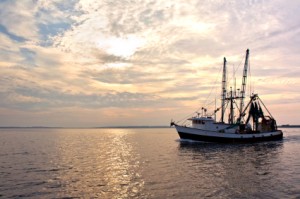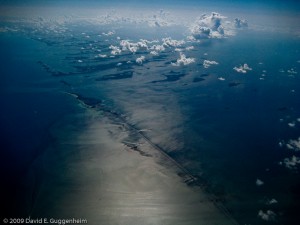Want to Help the Gulf of Mexico? Kill Your Lawn.

The Lawn has Become as much of an American Icon as Baseball and Apple Pie. But at What Cost? (Photo credit: From the cover of “The American Lawn” by Georges Tevssot)
Since 1948, radio station KBMW has been serving as the “Voice of the Southern Red River Valley,” a tri-state area including North Dakota, South Dakota and Minnesota, boasting some of the “richest farmland in the United States.” So why did they want to interview a city boy who lives for salt water? To update their listeners on the BP oil spill disaster in the Gulf of Mexico, and most importantly, tell their listeners how they could help. Like so many of us, they feel a deep connection to the Gulf, even from more than 1,200 from water’s edge, and the daily images of oil erupting from the BP well has led to palpable frustration. It’s hard to watch and not be able to help. Truth is, KBMW’s listeners are more connected than they may realize, and they can materially help the Gulf of Mexico — and their own neighborhoods, by just getting outside and doing some gardening.





 Fresh from the Eisenhower Administration era, your friendly neighborhood Ocean Doctor turned 50 today. In doing so, I outlived my father, William L. Guggenheim, who tragically died at 49 when he was lost at sea. It was my days as a boy, fishing with my dad off of Cape May, New Jersey, that I truly inherited his passion for the sea, and I feel lucky to have been able to spend much of my life near, in, or best of all, under the water.
Fresh from the Eisenhower Administration era, your friendly neighborhood Ocean Doctor turned 50 today. In doing so, I outlived my father, William L. Guggenheim, who tragically died at 49 when he was lost at sea. It was my days as a boy, fishing with my dad off of Cape May, New Jersey, that I truly inherited his passion for the sea, and I feel lucky to have been able to spend much of my life near, in, or best of all, under the water.
 Until that tranquil morning in late June 1974, the sum total of my SCUBA diving experience had been in a landlocked state, in a stifling, moldy indoor YMCA pool in the Philadelphia suburbs and a Pennsylvania quarry, flooded with icy soup-green water. Barely comprehending the new world of pungent humidity, mountainous afternoon cumulus clouds, and lush tangles of flowering succulents I experienced at water’s edge during my first visit to the Florida Keys, I was wholly unprepared later that morning when I found myself seated in sugar-white sand with 40 feet of warm, clear aquamarine water above my head. As impossibly multi-colored fish passed slowly within reach before my wide 15-year-old eyes, my gaze broadened as I marveled at the towering jetties of coral around us, living layer cakes of corals upon corals, brown and mustard rock-like structures, encrusted with brilliant red, violet and orange coralline fans and branches, swaying in the warm, nourishing current and, like eager spring blossoms, reaching toward the dancing sunlight scattered on the surface above.
Until that tranquil morning in late June 1974, the sum total of my SCUBA diving experience had been in a landlocked state, in a stifling, moldy indoor YMCA pool in the Philadelphia suburbs and a Pennsylvania quarry, flooded with icy soup-green water. Barely comprehending the new world of pungent humidity, mountainous afternoon cumulus clouds, and lush tangles of flowering succulents I experienced at water’s edge during my first visit to the Florida Keys, I was wholly unprepared later that morning when I found myself seated in sugar-white sand with 40 feet of warm, clear aquamarine water above my head. As impossibly multi-colored fish passed slowly within reach before my wide 15-year-old eyes, my gaze broadened as I marveled at the towering jetties of coral around us, living layer cakes of corals upon corals, brown and mustard rock-like structures, encrusted with brilliant red, violet and orange coralline fans and branches, swaying in the warm, nourishing current and, like eager spring blossoms, reaching toward the dancing sunlight scattered on the surface above.  If you know the
If you know the 